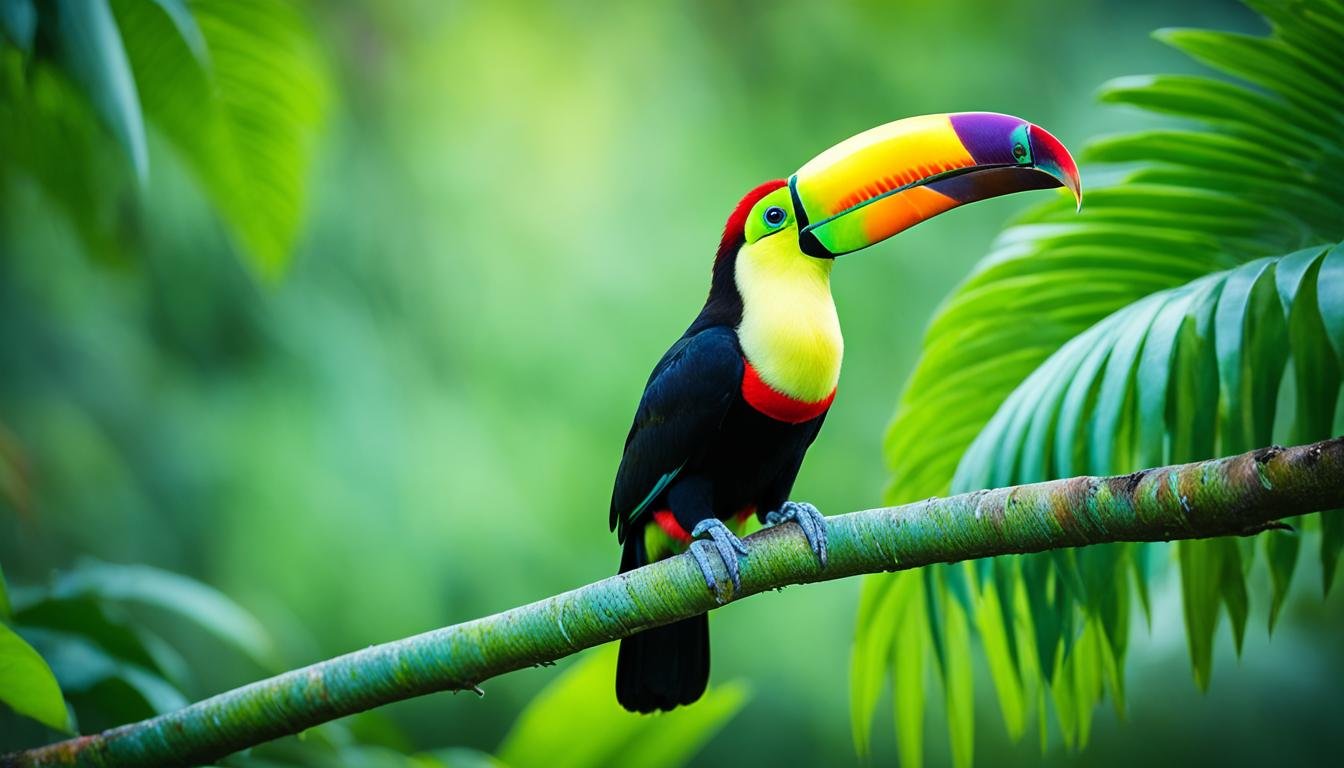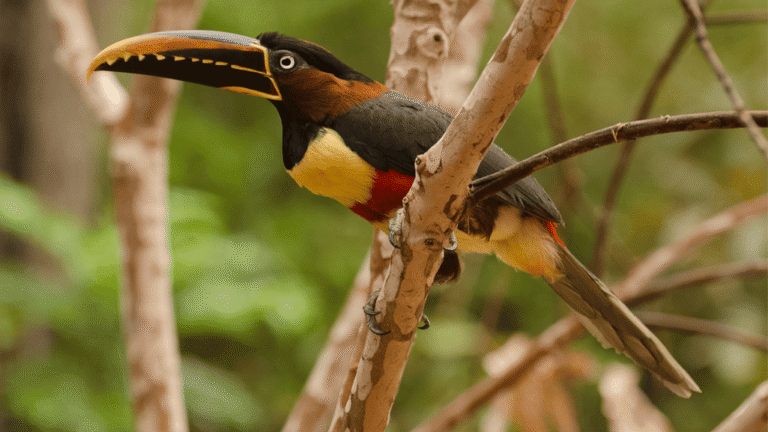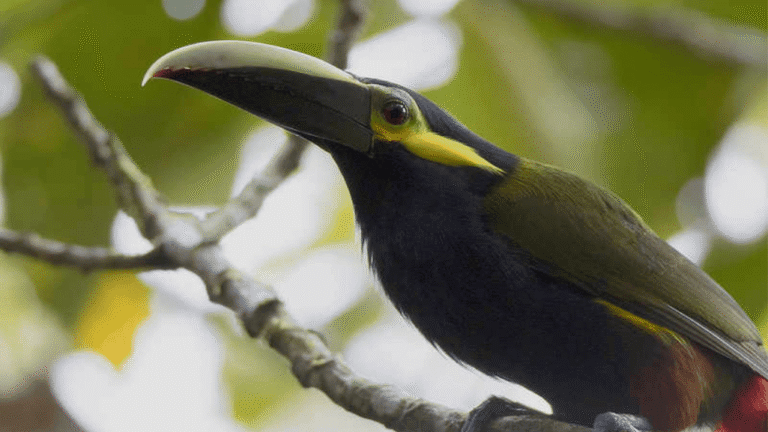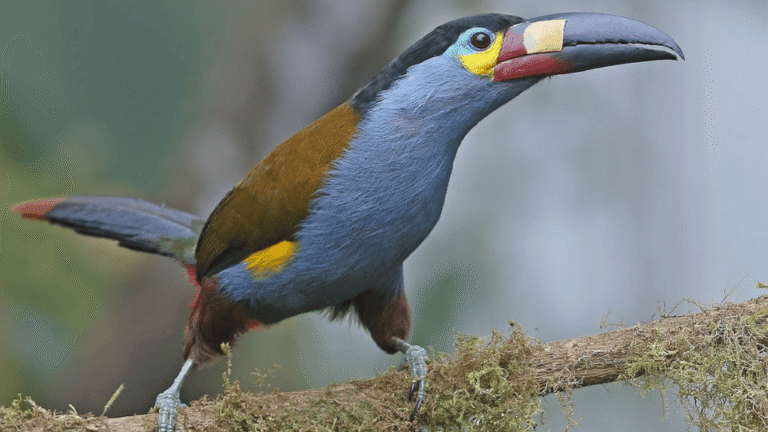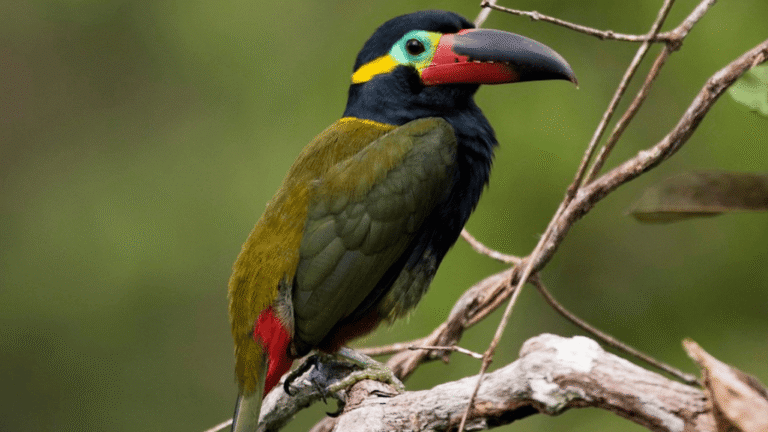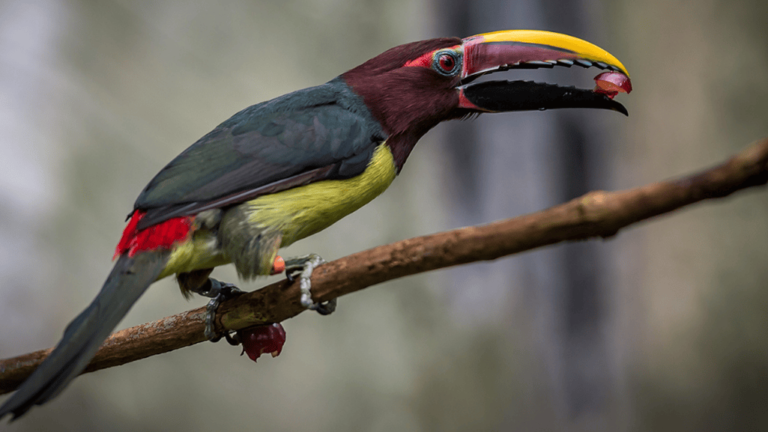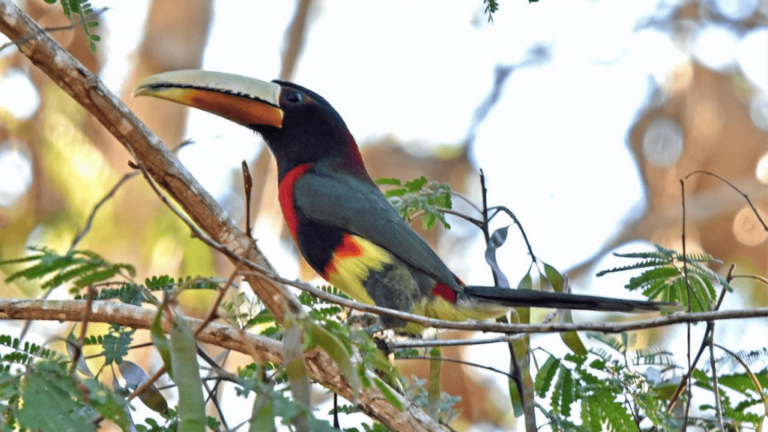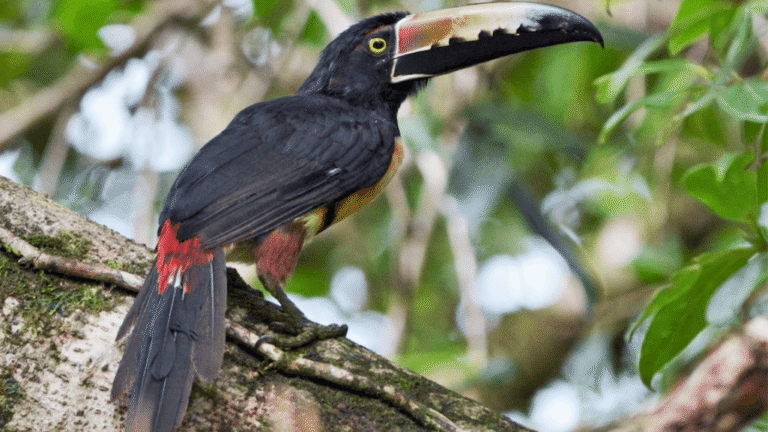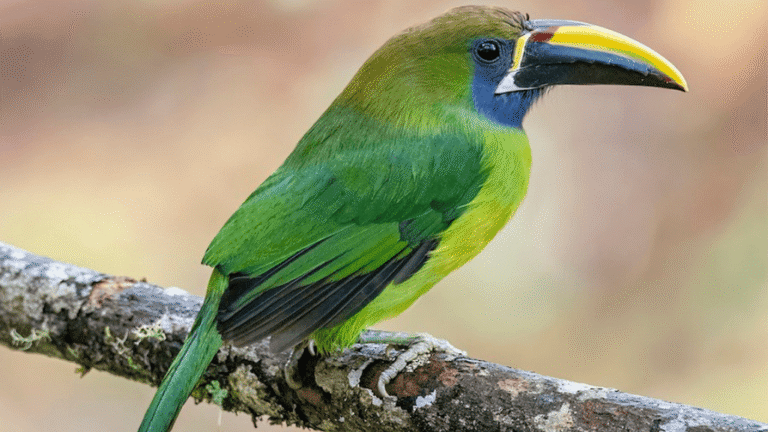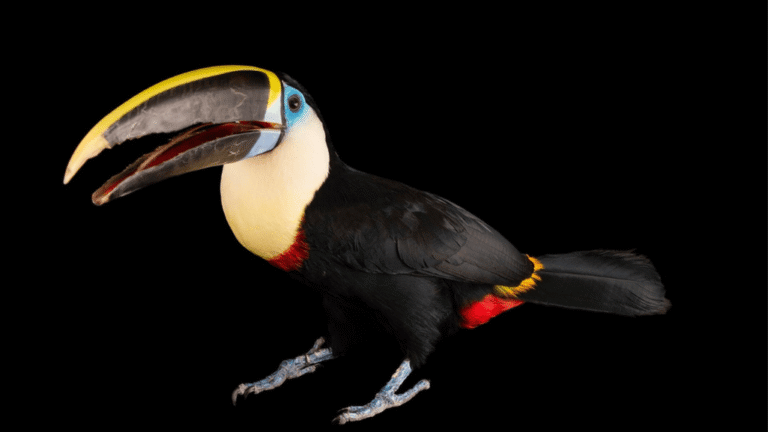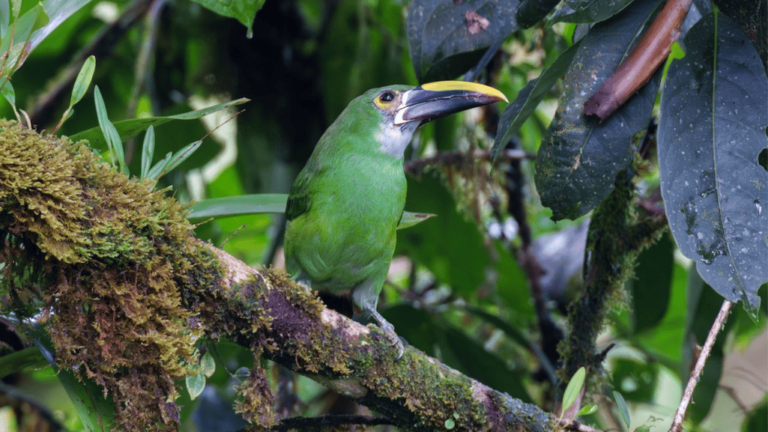The Keel-billed Toucan, also known as the Rainbow-billed Toucan, is a vibrant tropical bird that inhabits the rainforests of Central America. With its colorful feathers and large, multi-colored beak, it is a sight to behold in the wild. Keel-billed Toucans play an important role in the ecosystem as they help distribute seeds of various fruits, contributing to forest regeneration and the diversity of plant species. These magnificent birds are a delight for birdwatchers and nature enthusiasts in Central America.
The Keel-billed Toucan is widely distributed across countries such as Belize, Colombia, Costa Rica, Guatemala, Mexico, and Venezuela. It thrives in the lush green canopy of the tropical rainforest, where it finds abundant food sources and nesting sites. Birdwatchers and wildlife enthusiasts flock to the rainforests of Central America to catch a glimpse of this remarkable bird species.
Key Takeaways:
- The Keel-billed Toucan is a colorful tropical bird found in the rainforests of Central America.
- It has a large, multi-colored beak and vibrant feathers.
- The Keel-billed Toucan helps distribute seeds of various fruits, contributing to forest regeneration.
- It is widely distributed across countries like Belize, Colombia, Costa Rica, Guatemala, Mexico, and Venezuela.
- Birdwatchers and nature enthusiasts admire the beauty of the Keel-billed Toucan in its natural habitat.
Physical Characteristics of the Keel-billed Toucan
The Keel-billed Toucan is a visually stunning bird with remarkable physical attributes. Its predominantly black plumage provides a striking contrast to its vibrant and colorful bill. The bill, which is a prominent feature of the toucan, accounts for approximately one-third of its body length. It exhibits a dazzling array of colors, including green, orange, red, and blue, making it one of the most captivating features of this species.
The average size of a Keel-billed Toucan is around 50 cm (20 in). However, it’s important to note that a significant portion of its length is attributed to its remarkable bill, which measures approximately 20 cm (8 in). In terms of weight, the Keel-billed Toucan can reach up to 400 g (14 oz), reflecting its solid build and robust physique.
Aside from its colorful bill, the Keel-billed Toucan possesses other distinct physical characteristics. It sports red and white coverts on its tail, adding to its overall allure. The bird also features green skin around its eyes, enhancing its captivating appearance. Additionally, it boasts a yellow face and throat, accentuating its unique color palette. The toucan’s legs are blue, providing a contrasting yet harmonious hue. Furthermore, its tail is elegantly tipped with red feathers, further contributing to its overall aesthetic appeal.
| Physical Characteristics | Details |
|---|---|
| Plumage Color | Predominantly black |
| Bill Length | Approximately 20 cm (8 in) |
| Bill Colors | Green, orange, red, and blue |
| Size | Average of 50 cm (20 in) |
| Weight | Up to 400 g (14 oz) |
| Tail Coverts | Red and white |
| Eye Skin Color | Green |
| Face and Throat Color | Yellow |
| Leg Color | Blue |
| Tail Tip | Red feathers |
Habitat and Range of the Keel-billed Toucan
The Keel-billed Toucan is a fascinating bird species that thrives in the lush tropical and subtropical rainforests of Central America. Its natural habitat provides the perfect conditions for this colorful bird to thrive and fulfill its ecological role.
In its range, which stretches from southern Mexico to Colombia and northwestern Venezuela, the Keel-billed Toucan can be found soaring high above the treetops, rarely venturing to the ground. The thick vegetation and tall trees of the rainforests offer the toucans ample shelter, ideal nesting sites, and an abundance of food sources.
These toucans specifically favor areas with an abundance of fruit trees, which form a significant part of their diet. Their vibrant beaks are perfectly designed for reaching high-hanging fruit and extracting the seeds hidden within. This unique adaptation makes them important contributors to seed dispersal and the regeneration of the forest ecosystem.
During their foraging expeditions, Keel-billed Toucans form canopy-forging flocks, hopping between branches and exhibiting social behavior. These flocks, composed of several individuals, help ensure the survival of the species by providing protection against predators and enhancing their chances of finding food.
Belize, Bolivia, Colombia, Costa Rica, Guatemala, Honduras, Mexico, Nicaragua, Panama, and Venezuela are among the countries where the Keel-billed Toucan can be found. Its presence in these regions adds to the incredible biodiversity and natural richness of the tropical and subtropical rainforests.
| Keel-billed Toucan | Tropical and Subtropical Rainforests |
|---|---|
| Habitat | Tropical and subtropical rainforests with dense vegetation and tall trees |
| Range | Southern Mexico to Colombia and northwestern Venezuela, including countries like Belize, Bolivia, Colombia, Costa Rica, Guatemala, Honduras, Mexico, Nicaragua, Panama, and Venezuela |
| Preferred Food Sources | Fruit trees and berries, which form a significant part of their diet |
| Social Behavior | Form canopy-foraging flocks, exhibiting social behavior and providing protection and improved foraging opportunities |
| Ecological Role | Contribute to seed dispersal and forest regeneration through their feeding habits |
Behavior and Diet of the Keel-billed Toucan
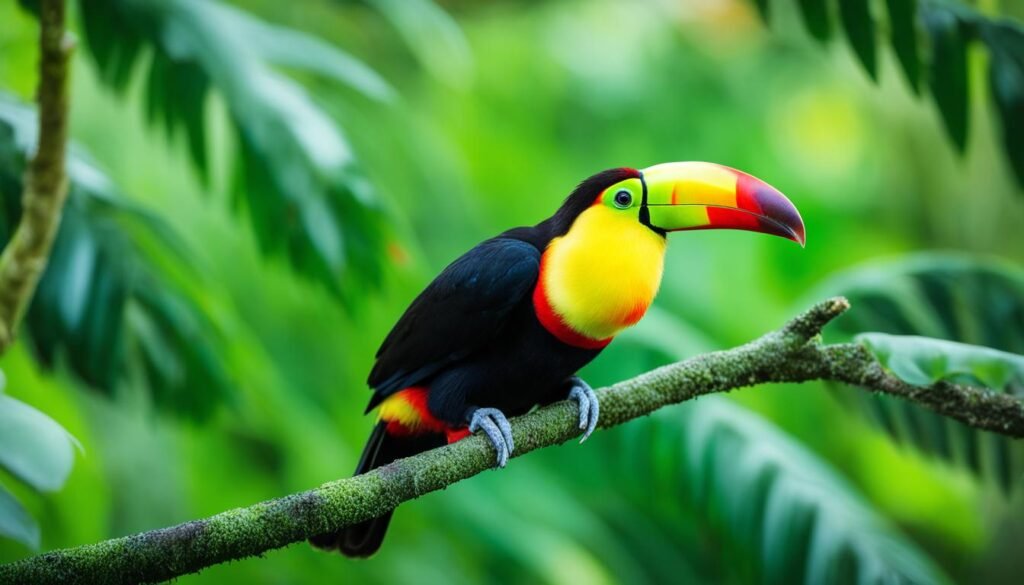
Keel-billed Toucans, known for their distinctive appearance, also exhibit unique behaviors and feeding patterns. They are diurnal birds, meaning they are active during the day and sleep at night. These social birds often form small flocks and engage in playful behaviors, such as tossing and catching fruit, which is a fascinating sight to behold.
The diet of Keel-billed Toucans primarily consists of fruits and berries, making them frugivorous birds. They have a preference for a wide variety of fruits, including figs, palm fruits, and guavas. Their large and curved bills enable them to reach high-hanging fruit and extract seeds from inside their shells, showcasing their remarkable adaptability.
While fruits form the mainstay of their diet, Keel-billed Toucans also consume insects, reptiles, and small birds. Insects provide them with vital protein, while small reptiles and birds serve as additional sources of nutrition. These dietary habits contribute to the diversity of their feeding patterns, highlighting their versatility as omnivorous bird species.
The feeding behavior of Keel-billed Toucans also contributes to the health of their surrounding ecosystems. When they consume fruits, undigested seeds pass through their digestive system and are expelled in their droppings. This process aids in seed dispersal and plays a valuable role in forest regeneration.
The intriguing behaviors and diverse diet of the Keel-billed Toucan make it a fascinating bird species to study and appreciate. Its interactions with various food sources and the role it plays in maintaining the balance of tropical rainforest ecosystems highlight its ecological importance.
Reproduction and Lifespan of the Keel-billed Toucan
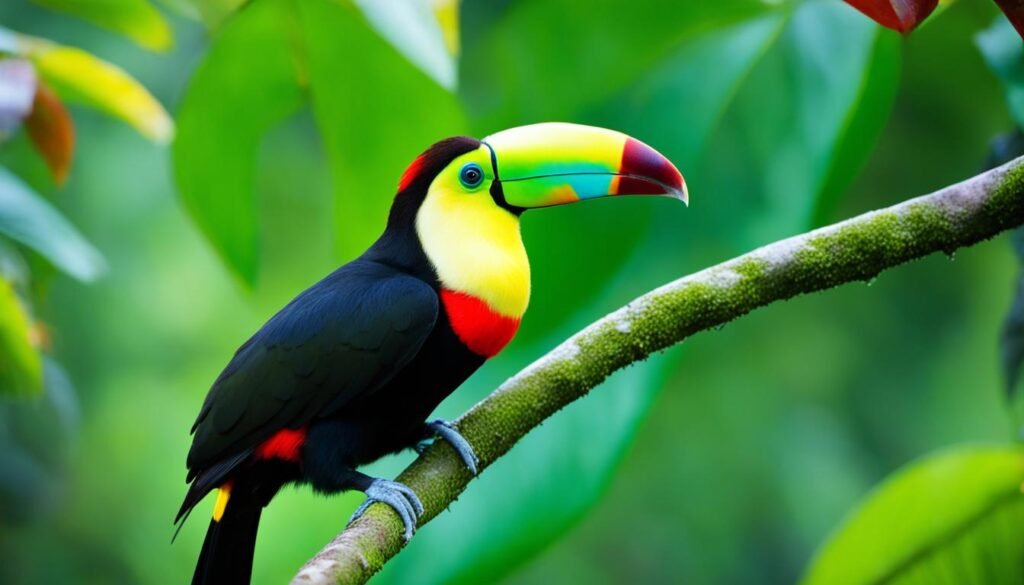
Keel-billed Toucans are fascinating birds that engage in monogamous relationships and form long-term pair bonds. Their reproductive process involves nesting in tree cavities and the female laying 2 to 4 eggs per clutch.
Both parents take turns incubating the eggs, which typically hatch after a period of 16 to 20 days. When the chicks emerge, they are born naked and with their eyes closed, relying entirely on their parents for care and protection.
Over the course of 8 to 9 weeks, the fledglings undergo rapid growth and development, eventually developing strong bills that are vital for their survival. During this stage, the parents provide dedicated parental care, ensuring the chicks receive sufficient food and nourishment.
The lifespan of a Keel-billed Toucan is relatively long, often ranging from 15 to 20 years. These majestic birds have adapted to their environment to ensure successful reproduction and the survival of their species.
Parental Care
- Both parents take turns incubating the eggs and protecting the nest.
- The parents actively feed the chicks and ensure they receive proper nourishment.
- They regurgitate food to feed the young, providing them with a balanced diet.
- The parents play a crucial role in the growth and development of the chicks.
Chick Development
- The chicks hatch without feathers and with their eyes closed.
- They rely on their parents for warmth, protection, and food.
- Within a few weeks, the chicks rapidly grow and develop their distinct features.
- They develop strong bills, which will become essential for foraging and survival.
Lifespan
- The average lifespan of a Keel-billed Toucan is 15 to 20 years.
- Factors such as habitat quality, predation risks, and disease can influence their longevity.
- Conservation efforts are crucial to ensuring the survival of these magnificent birds.
Threats and Conservation of the Keel-billed Toucan
While the Keel-billed Toucan is currently listed as a species of least concern by the IUCN, it faces several threats to its survival. Habitat loss due to deforestation is a significant concern, as many rainforest areas where the toucans reside are being cleared for agriculture and urbanization.
The illegal pet trade also poses a threat, as these colorful birds are highly sought after. Additionally, hunting for their meat and feathers has negatively impacted some populations.
| Threats | Description |
|---|---|
| Habitat Loss | Deforestation for agriculture and urbanization |
| Pet Trade | Illegal trade for exotic pets |
| Hunting | Killing for meat and feathers |
Conservation efforts are essential to protect the Keel-billed Toucan and its habitat. Measures such as habitat restoration, protected area management, and raising awareness about the importance of biodiversity are crucial.
Interesting Facts about the Keel-billed Toucan
In addition to its striking appearance, the Keel-billed Toucan boasts several fascinating features and cultural significance that sets it apart from other bird species.
- Hollow Bill: Despite its large size, the toucan’s iconic beak is surprisingly light and hollow. This unique adaptation allows the bird to maneuver its bill with precision and agility.
- Courtship Displays and Defensive Weapon: Scientists believe that the toucan’s bill plays a crucial role in courtship displays, with males using it to show off their vibrant colors and attract potential mates. The bill also serves as a formidable defensive weapon, capable of warding off predators.
- Loud and Distinctive Calls: Toucans are known for their loud and distinctive calls, resembling frog-like croaks. These calls can travel for impressive distances, with their sound carrying up to half a mile away.
- Cultural Significance: In certain cultures, toucans hold folklore and spiritual significance. They are sometimes believed to be representations of evil spirits or used as tribal totems, symbolizing wisdom, strength, and abundance.
These interesting facts about the Keel-billed Toucan have made it a subject of fascination for birdwatchers and wildlife photographers, attracting attention and admiration worldwide.
Conclusion
The Keel-billed Toucan is a remarkable bird species found in the tropical rainforests of Central America. With its vibrant feathers and large beak, it captivates the attention of birdwatchers and nature enthusiasts. However, the toucan also faces threats from habitat loss, the pet trade, and hunting.
It is crucial to prioritize conservation efforts to protect the toucan’s habitat and promote biodiversity. By preserving the rainforests and raising awareness about these unique birds, we can ensure the long-term survival of the Keel-billed Toucan and the delicate ecosystems it calls home. Conservation initiatives, along with sustainable practices, are key to securing a future for this colorful and iconic bird species.
As the rainforests continue to shrink due to human activities, the presence of the Keel-billed Toucan becomes more vulnerable. The loss of their habitat not only affects the survival of these magnificent birds, but also disrupts the intricate balance of the rainforest ecosystem. Protecting the rainforests and the biodiversity they harbor is essential not only for the Keel-billed Toucan, but for countless other species that rely on these unique habitats.
In conclusion, conserving the Keel-billed Toucan and its rainforest habitat is of utmost importance. Through collective action, we can make a significant impact in preserving the natural wonders of Central America and ensuring a brighter future for the Keel-billed Toucan and the rich biodiversity it represents.
Frequently Asked Questions
What is a Keel-billed Toucan?
The Keel-billed Toucan, also known as the Rainbow-billed Toucan, is a vibrant tropical bird found in the rainforests of Central America. It is known for its colorful feathers and large, multi-colored beak.
Where can I find the Keel-billed Toucan?
The Keel-billed Toucan is distributed in countries such as Belize, Colombia, Costa Rica, Guatemala, Mexico, and Venezuela. It inhabits tropical and subtropical rainforests in Central America.
What does the Keel-billed Toucan eat?
The Keel-billed Toucan primarily feeds on fruit, but it also consumes insects, reptiles, birds, and eggs.
What is the lifespan of a Keel-billed Toucan?
The average lifespan of a Keel-billed Toucan is 15 to 20 years.
Why is the Keel-billed Toucan listed as a species of least concern?
Although the Keel-billed Toucan faces threats such as habitat loss and the illegal pet trade, it is currently listed as a species of least concern by the IUCN due to its relatively stable population.
What are the threats to the Keel-billed Toucan?
The Keel-billed Toucan faces threats from habitat loss, the illegal pet trade, and hunting for its meat and feathers.
Are Keel-billed Toucans social birds?
Yes, Keel-billed Toucans are social birds that often form small flocks and engage in playful behaviors.
What is the significance of the Keel-billed Toucan’s bill?
The Keel-billed Toucan’s bill is hollow and lightweight, and it plays a role in courtship displays and serves as a defensive weapon.
How can we help conserve the Keel-billed Toucan?
Conservation efforts such as habitat restoration, protected area management, and raising awareness about the importance of biodiversity are crucial to protect the Keel-billed Toucan and its habitat.


